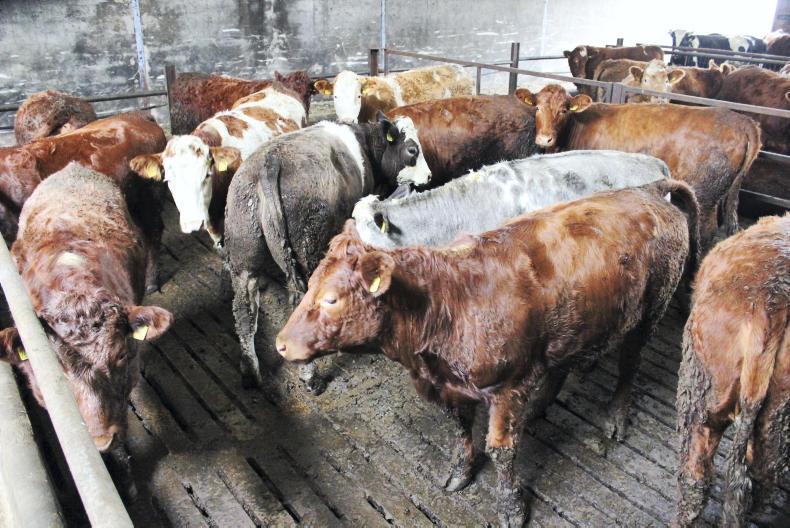This week, Kieran Mailey speaks to two of the farmers involved in the previous phase. With a less prominent role in this phase, they provide advice, guidance and support to the new farmers
Wet weather has definitely made an impact on grazing ground. Ground conditions have been poor and some fields are still saturated.
We moved 34 cows with bull calves off grazing ground the weekend before last. As housing is not set up for cows and calves, I moved them on to stone laneways and hardcore areas temporarily, as ground was simply too wet to carry stock.
Cows were offered silage in round feeders for one week. It was far from ideal, but it prevented ground from severe poaching.
Bull calves were weaned and housed last weekend. Prior to housing, I started the weaning process using the QuietWean nose tags. We have used these for a number of years now and they work well in our system.
Stress
However, the whole process of moving calves off grass, housing and weaning did create a few problems with pneumonia.
Eight out of the 34 calves needed treating and they have since recovered.
Ideally, the calves would have been weighed at weaning. But I did not want to put them under further stress from handling, so they were allowed to settle.
I weighed them this week, with the 34 animals averaging 294kg at an average age of 186 days.
Adjusting this weight to 200 days of age would give them an average weight of 313kg.
Bull calves are now housed until they are finished. They have just started eating meal at 1kg/day and will be built up to 4kg/day inside the next fortnight. After this point, they will move on to a total mixed ration for the winter.
Cows
All cows are now scanned. From a group of 93 cows bred over the summer, there are eight animals not in-calf.
I have more cows marked for culling, so there will be a total of 17 cows to offload this winter.
The cows are on ad-lib silage at the moment, but meal will be introduced shortly. Some cows will be ready to kill by November, with the remainder killing in December.
With a good supply of heifers due to calve next spring, I can cull hard on cows. There are 21 heifers scanned in-calf from a group of 27 put to the bull.
After weaning, the cows were moved to the outdoor slatted tank and are now being fed silage. My plan is to get dry cows back to grass.
Weather-dependant, they will get another month to graze along with store cattle before housing for a TB test.
Like most farmers, we have had to react to the continued wet weather by housing cattle much earlier than planned. We started housing cattle on 9 September. By the following weekend, all stock were indoors with the exception of spring-born heifers and a few in-calf heifers.
Early housing created a few problems around winter forage. We were going to be short on silage, so early action was needed to source additional forage before it would become a bigger problem.
Round bales were purchased, along with an additional pit of silage from a neighbouring farm. Silage cost £35/t, which is more than I had initially budgeted, but it is required to meet feed demand.
We also managed to make a small third cut of silage earlier this week.
Along with purchasing additional forage, we have made arrangements for store cattle to move to another farm under a B&B arrangement for winter feeding.
We will provide meal, while the farmer provides silage and feeds the cattle daily through a wagon with the meal mixed in.
Cows
This leaves us with cows and finishing cattle to look after during the winter. I wanted to keep cows at home to monitor body condition.
Cows are carrying plenty of flesh at the moment and will be grouped shortly based on body condition. Silage can then be fed accordingly.
With cows housed, we decided to go ahead and wean their calves.
We have 70 calves now weaned and it worked well. Normally, calves are weaned outside by removing cows from the group.
But this year, calves were locked away from the cows in the evening in a separate pen and offered meal.
The next morning, calves were allowed back in to suckle the cows. After one week, cows were moved to a different shed and calves remained settled. Cows are being fed the drier bought-in silage.
All cows are now scanned and I am happy with how breeding went. From 86 cows and heifers, we have 81 females confirmed in-calf.
There are 17 in-calf heifers in this group. Based on scanning dates, cows should start calving in late February with peak calving around the second week in March.
Finishing cattle
We have a group of 40 steers and heifers due to finish in December, although there will probably be a handful of Shorthorn animals run into January. They are being fed ad-lib silage and a bought-in finishing blend costing around £180/t.
Alongside the prime cattle, there is a group of 12 cull cows separated out and being finished also. These include the cows that scanned empty and a few cows to be culled because of poor performance.
